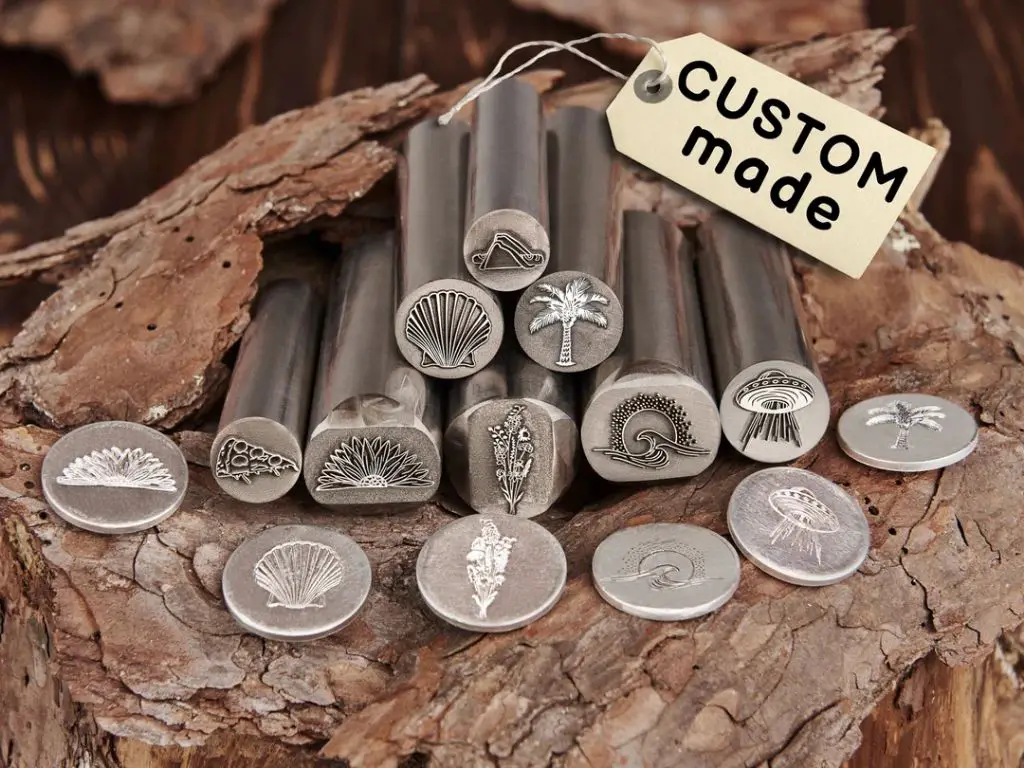What Do Metal Stamps Mean?
A metal stamp is a tool used to imprint lettering, symbols, numbers, or designs onto metal surfaces. Metal stamps have been used throughout history for marking precious metals like silver and gold, as well as for industrial purposes like branding metal parts. The process of using a stamping tool to impress a design onto metal is known as metal stamping.
Metal stamping dates back thousands of years, with some of the earliest known examples being ancient coins produced in Lydia (modern-day Turkey) around 650 BC. Over the centuries, metal stamps evolved from hand-carved dies to more sophisticated engraved or machined steel tools able to imprint designs consistently and quickly.
Today, metal stamps are used across many industries including jewelry, metal fabrication, automotive, aerospace, and firearms. Common applications include marking precious metals with purity stamps like sterling silver or 18k gold, imprinting serial numbers or logos onto metal parts and products, or adding decorative effects. In manufacturing, metal stamping may be done on a large press or a small arbor press in a workshop.
Understanding how to read and identify the various stamps found on metal products provides insight into their origins and qualities. This guide will overview the common types of metal stamps and their meanings.
Hallmarks
A hallmark is an official mark or series of marks struck on items made of precious metals, mostly silver and gold. These marks serve as a guarantee of purity or fineness of the metal. Hallmarks are applied by an assay office under the control and administration of an authorizing government or organization (https://www.arnarson.net/blog/what-are-hallmarks).
Hallmarks have a long history dating back to the 14th century. As the silversmith’s guilds grew in power, they instituted a system of hallmarks to combat counterfeiting and guarantee purity. Today, hallmarks continue serving the same essential functions (https://www.arnoldjewelers.com/jewelry-hallmarks/).
There are several types of hallmarks:
- Maker’s mark – Identifies the manufacturer or designer
- Purity mark – Indicates metal purity or fineness (e.g. 925 for sterling silver)
- Assay office mark – Indicates which assay office tested the metal
- Date letter – Denotes when an item was hallmarked
Some of the most common hallmarks found on jewelry include “925” and “14K,” denoting sterling silver and 14 karat gold respectively. Understanding how to decipher the meanings behind hallmarks is important for determining the value and authenticity of antique and vintage jewelry (https://applesofgold.com/jewelryblog/2009/02/jewelry-hallmark-guide/).
Maker’s Marks
A maker’s mark is a unique symbol or set of initials that identifies the jeweler or studio where a piece of jewelry was made. Maker’s marks serve as a signature for artisans and designers, allowing their work to be recognized and attributed to them.
The purpose of a maker’s mark is to identify the creator and origin of a particular jewelry item. This helps establish provenance and assists with authentication for antique and vintage pieces. Maker’s marks first became popular during the Victorian era as mass production grew and competition between jewelers increased. Today, they continue to be an important way for jewelers to sign their creations.
Maker’s marks are registered with organizations like the Jewelers’ Vigilance Committee in the U.S. The mark typically consists of the jeweler’s initials, although it may also contain a logo, symbol, or stylized design. Popular American examples include the letters AJM for Arpad Joopin Maker, TFH for Tiffany & Co., and HR for Henry Robbins. Luxury European jewelers often use more elaborate marks, like Cartier’s two letter C’s surrounded by a circle.
Whenever an artisan produces a new piece of jewelry, they will stamp or engrave their unique maker’s mark on the metal. This permanent marking ensures the jewelry can be traced back to them as its creator. Over time, the ability to identify a maker’s mark makes a vintage or antique piece more valuable to collectors and buyers.
Quality Marks

Quality marks indicate the purity or fineness of the precious metal content in jewelry or silverware. They specify the exact percentage of precious metal alloys used. Some common quality marks seen on jewelry include:
Sterling Silver – The most common silver alloy, sterling silver, is 92.5% pure silver mixed with 7.5% copper or other metals. The number 925 indicates 92.5% pure silver content. (Source)
Platinum – Platinum jewelry is marked PT or PLAT, indicating 95% pure platinum. Some may also have iridium alloyed. (Source)
18K Gold – 18K gold contains 75% pure gold mixed with 25% copper or silver. The number 750 indicates 75% pure gold content. Other gold purities include 24K as pure gold and 14K as 58% pure gold.
Quality marks allow consumers and regulators to verify the purity of precious metals. They deter deceptive labeling and confirm that alloys meet legal standards for fineness.
Date Letters
Date letters are one of the key components of British hallmarks used to identify the year a silver item was assayed and marked. They consist of a single letter stamped near the maker’s mark and change annually in May when the financial year ends for the assay offices.
The date letter does not directly correspond to a calendar year. For example, the letter for 2013 was “c” while 2014 was “d.” This is because the letter sequence repeats every 20 years (though some offices cycle through 18 or 22 letters). So a “d” for 2014 represents a different year than a “d” for 1934. Date letters have been used in their current format since 1761.
According to Silver Date Marks, the complete date letter series for major British assay offices are as follows:
London – a, b, c, d, e, f, g, h, j, k, l, m, n, o, p, q, r, s, t, u
Birmingham – a, b, c, d, e, f, g, h, j, k, l, m, n, o, p, q, r, s, t, u
Sheffield – A, B, C, D, E, F, G, H, J, K, L, M, N, O, P, Q, R, S, T, U
Edinburgh – a, b, c, d, e, f, g, h, j, k, l, m, n, o, p, q, r, s, t, v
Identifying the date letter along with the maker’s mark allows collectors and appraisers to date and authenticate silver items.
Assay Marks
Assay marks indicate that a piece of jewelry or silverware has been tested for purity by an independent testing facility known as an assay office. An assay mark shows that the item contains at least the minimum amount of precious metal stated.
There are several types of assay marks:
- Hallmark – Indicates the purity of gold and some platinum jewelry. Can be marked in karats or fineness.
- Sterling Mark – Indicates silver purity of at least 925 parts per 1000.
- Platinum Mark – Denotes at least 95% pure platinum.
Assay marks are commonly found on jewelry, silverware, and decorative metalwork. They are typically located inconspicuously on the inside rim or clasp of jewelry. On silverware and metalwork, marks may be found on the underside or other discreet location.
The main purpose of assay marks is to certify that an item meets a certain standard of precious metal purity determined by law. They provide consumer protection and prevent fraud.
Some examples of well-known assay offices include:
– Sheffield Assay Office
– London Assay Office
Other Common Stamps
In addition to marks indicating metal purity or maker, there are many other common stamps found on metal items like jewelry, silverware, and watches.
Plating Stamps: Items that have been plated with another precious metal may include stamps indicating the type of plating. Common plating stamps include GEP for gold electroplated, SEP for silver electroplated, RGP for rolled gold plated.
Flatware Stamps: Spoons, forks and knives will often have stamps indicating the style or pattern of the flatware. Some flatware stamps include EPNS for electroplated nickel silver flatware or 18/10 for 18 karat gold plated over a base metal of 10% nickel.
Watch Stamps: Watch cases and movements will contain stamps indicating the metal content or plating. These include stamps like GP or HGE for gold plated cases, SS for stainless steel, and 10K, 14K, 18K stamped inside cases or on watch movements to mark the karat of gold alloys.
How Stamps Are Applied
There are several techniques used to apply stamps to metal objects:
Hammer Stamping – This is the most basic stamping method. A metal stamp is placed on the metal surface and struck with a hammer to imprint the design. Multiple hits may be required to get a clear impression. Hammers can be made of wood, rubber, plastic or metal 1.
Press Stamping – Stamping presses apply high pressure to imprint designs using a stamping die. Presses range from simple handheld tools to fully automated machines. This allows consistent, high-volume stamping. Common types of stamping presses include mechanical, hydraulic, pneumatic and digital 2.
Etching – An etching solution is applied to chemically erode the metal surface. A wax resist can be used to create a design. Etching produces a shallow impression, unlike the deep imprints of hammer or press stamping.
Engraving – Engraving machines use specialty bits to carve patterns into metal. This removes material to a specified depth. Hand engraving is also done using specialized engraving tools and techniques.
Casting/Molding – Molten metal is poured into a mold containing a stamp design. When cooled, the solid metal object retains the imprinted design. This is often used for medallions and jewelry charms.
Laser Engraving/Etching – A laser uses precise, concentrated energy to etch designs into metal surfaces. This provides high detail while avoiding tool marks.
Reading and Identifying Marks
Properly identifying the marks stamped on a piece of silver requires some knowledge and detective work. Here are some tips for reading marks and identifying pieces:
Start by looking for a dominant maker’s mark. This is usually the largest and most prominent stamp, and identifies who manufactured the piece. Maker’s marks can consist of initials, full names, logos, or symbols.
Next check for additional tiny stamps known as hallmarks. These indicate purity, date of manufacture, and location. Hallmarks are standardized according to nation; familiarize yourself with the hallmark systems of different countries.
Use a magnifying glass if needed. Some stamps and letters can be extremely small. Proper lighting and angling the piece can also help make marks more visible.
Refer to online databases like https://specialtyappraisals.com/silver-tips/ to look up registered maker’s marks and identify unrecognized stamps.
If you can’t find exact matches, look for similarities to narrow down the maker, time period, and origin. Marks changed over time, so comparing to examples from the same era can help.
Take care not to mistake stamps for scratches or wear. Focus on intentional impressions rather than random marks.
With some patience and research, the meanings behind silver stamps can be uncovered. Proper identification provides insight into an antique or vintage silver piece.
Conclusion
In summary, metal stamps provide important information about an item’s origins, manufacturer, quality, and date of production. For collectors and buyers, understanding how to read these marks is essential for identifying and authenticating pieces, assessing their value, and tracing their history. The markings signify key details about when and where something was made, what materials were used, and the level of craftsmanship involved.
Hallmarks, maker’s marks, assay marks, date letters, and other stamps each convey specific details that together help create a comprehensive record. Although reading these marks requires some knowledge and effort to decipher, doing so provides insight into an item’s origins and provenance.
For those looking to collect or invest in metalwork, from silverware to jewelry, decoding the markings is an invaluable skill. It allows collectors to confirm the authenticity of a piece before purchase. Understanding stamps also enables proper cataloging and research on items already owned. Overall, familiarity with the language of markings opens up appreciation for the rich histories behind decorative and functional metal goods.




